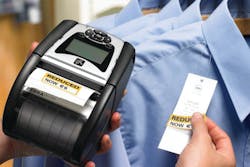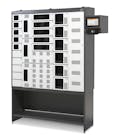Inside Zebra’s acquisition of Motorola Solutions’ Enterprise Business
Last week, Zebra Technologies, a manufacturer of ID card printers and barcode scanning solutions announced that it has entered into an agreement to acquire Motorola Solution’s Enterprise Business for $3.45 billion. The transaction has been approved by the boards of directors of both companies and is expected to be completed by the end of 2014. Zebra said the acquisition should strengthen its position in key vertical markets such as retail, transportation and logistics, and manufacturing. SIW recently caught up with Phil Gerskovich, senior vice president at Zebra Technologies, to discuss the impact of the acquisition on both companies and how it will affect their development of current and future solutions.
SIW: What was the major impetus for this acquisition?
Gerskovich: These two organizations have worked together really for more than 20 years. This part of Motorola - although there were several acquisitions in the past few years - came from a company they bought called Symbol Technologies and they were really famous for their breakthrough work in laser barcode scanning and were an early leader in mobile, handheld computers. Zebra and Symbol have worked together for many years, typically at both ends of the barcoding chain. We would make the barcodes and they would scan them. Over many years, we typically sold in very complementary ways and, in many cases, to the same customers and reseller partners. People would ask over the years, ‘why aren’t you guys both in the same organization since you’re really part of the same solution?’ It never made sense from a number of business reasons to bring all of the pieces together, although frankly over the years it was discussed a lot on both sides I think. In the last year here as our CEO and the CEO of Motorola would talk frequently, the question kept coming up about what were the best ways to kind of get benefits from bringing these two sides together? Motorola recently decided that it was in their best corporate interests to divest these assets and we participated in a process to buy them and we’re pleased that we were able to acquire the assets.
SIW: What kinds of enhanced capabilities will Zebra be able to provide customers by bringing Motorola Solutions’ Enterprise Business into the fold?
Gerskovich: There is existing benefits to our customers and us. As I say, it certainly gives our customers one throat to choke when they’re deploying various kinds of automatic identification solutions – whether it is barcode or RFID. When they’re tracking assets in almost any environment there is either a Zebra or Motorola solution there, so we really now become part of the same company and our customers will have one partner to work with and I think that’s one of the most important reasons to do this. Going forward, we see a lot of real synergies as the world continues to move forward in I think two key growth areas. One key growth area is what we call the “Internet of Things” and that is all about everyday devices that are accessible on the Internet. The other key area is the mobile worker and we’re a big believer that in the next 10 years, virtually all enterprise applications will be delivered through a cloud service and that they will be rewritten to use both on the desktop and in mobile devices. We think those two trends are really going to change the way that enterprises track and manage assets - whether they’re people, things in the supply chain or pharmaceuticals – and by bringing these two pieces together, we can really deliver superior solutions than we could if we were separate organizations.
SIW: Being known for ID card printing and barcode scanning, how does this acquisition help you branch out from that?
Gerskovich: We are known a lot in both of those areas. In the ID card business, for instance, we were the first and I still think the only company that sells ID card printers that also encode passive RFID in the 900-megahertz band, which is the more common one used in the supply chain. That’s an example of kind of where we’re able to leverage something in another area like RFID technology into that business. The Motorola assets, which besides their mobile handheld computers, also includes their industry leading passive RFID reader business and a wireless LAN business. On the deeper side, we have the Zebra Zatar software platform which is designed to build Internet of Things (IoT) applications. We think that by bringing all of these assets together, we can really give new kinds of solutions that would have been very difficult to build just a few years ago. The combination of smartphone technology, RFID and IoT we believe will be transformational for security systems. We have a range of technologies that can locate, identify and tell the condition of assets – whether fixed or on the move – and as part of that, we also have some new technologies like iBeacon technology which we’ve demonstrated in a number of applications both in retail and healthcare that can become part of new IoT solutions.
SIW: How do you plan to physically integrate the two companies together?
Gerskovich: It can take as long as nine months for the deal to close depending on government approvals, although we’re hopeful for it to close sooner than that. We believe that, as in any deal of this magnitude, integration issues will take a lot of careful time and attention from both companies’ management. It is made somewhat easier by the fact that both companies headquarters are in the same general area, they’re both in the Chicago suburbs and we’ve sold to common customer bases for many years. We’re coming together with more knowledge about each other and the way we go to market than two companies would normally have. We believe that that will help make the process simpler. Our goal will really be to leverage the strength of each company in a complementary way. While we’re very overlapped in terms of the way we go to market, there are some differences in some vertical markets and some regions and we hope to really benefit each other in that way where we can get greater coverage in different vertical markets and geographies as we go forward.
SIW: Have you had any talks about your branding strategy moving forward?
Gerskovich: As part of this acquisition, we are in agreement that we will be transitioning away from the Motorola brand for the products we’re acquiring. Having said that, we haven’t decided yet on the long-term branding strategy. That’s going to be one of the things we’re going to be working on over the next several months.
SIW: Will this acquisition boost your performance in or help you enter vertical markets that you previously were not a big part of?
Gerskovich: I think there are two aspects to our vertical expansion. One is the fact that there are some verticals today where one company is a little bit stronger, so I think that will help bring the other side into those vertical markets. Secondarily, we will have the wherewithal to do more market development in new verticals. We do believe that vertical market expansion will be an important part of our growth strategy going forward.



